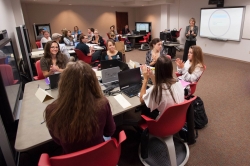
SUNY Buffalo State faculty members who have embraced active learning have an ally in a new classroom, E. H. Butler Library 316. Active learning in a classroom setting requires students to tackle the subject material themselves—through means such as discussion, reflection, and problem-solving—as opposed to relying solely on professors’ lectures.
Melaine Kenyon, director of instructional technology, could barely contain her enthusiasm as she showed off the room’s features. A console at the professor’s station has a touch panel that enables the instructor to manage the large classroom monitor as well as six smaller monitors in the room. Each small monitor sits at the head of a table that has six spaces for students. And each student station has a laptop that students can use to do research online, share it on their group’s monitor, and develop a class presentation together.
“We have a lot of demand for this space,” said Kenyon. “Professors who use active learning love it.”
 Carol DeNysschen, associate professor of dietetics and nutrition, is among them. “In class, I teach a concept, and then I give the students an assignment that requires them to apply what I just taught,” she said. “They have to process the information right away and use it to think critically about a real-world situation.”
Carol DeNysschen, associate professor of dietetics and nutrition, is among them. “In class, I teach a concept, and then I give the students an assignment that requires them to apply what I just taught,” she said. “They have to process the information right away and use it to think critically about a real-world situation.”
DeNysschen thinks of each work area as a “pod” with six students. In a recent class about nutrition, she gave each group a different advertisement about nutrition claims. “First they had to analyze the ad, and then each student used the individual laptops to do research online to see how the ad was a bit misleading,” said DeNysschen. “Then they worked together to put together a presentation for the entire class.” DeNysschen requires each student to take part in the group’s presentation.
Along the way, the students learn from each other, and each student contributes. DeNysschen walks around the room to answer questions and make suggestions. “It’s also easy for me to see if the students understood the concept I presented,” she said.
The room is the latest product to result from Kenyon’s effort to bring cutting-edge technology to Buffalo State’s classrooms. In 2006, she was asked to convert a number of campus classrooms to “smart” classrooms. For starters, she asked faculty members what they wanted in a classroom.
“One big request was flexibility,” she said. “Flexible lighting, so they could show something on a screen and students could still take notes. Flexible seating, so that students could work in groups or individually. Tables that facilitated collaboration among students.”
Butler 316 combines these early requests with a networked system that features three modes— teach, collaborate, and present. By setting the mode with the control panel, the professor can teach new material, allow students to collaborate in individual groups, and present each group’s effort to the class.
“In a lecture class, a student can just take notes mindlessly,” said DeNysschen. “Here, they have to process and apply the information right away. My classroom is alive now.”
